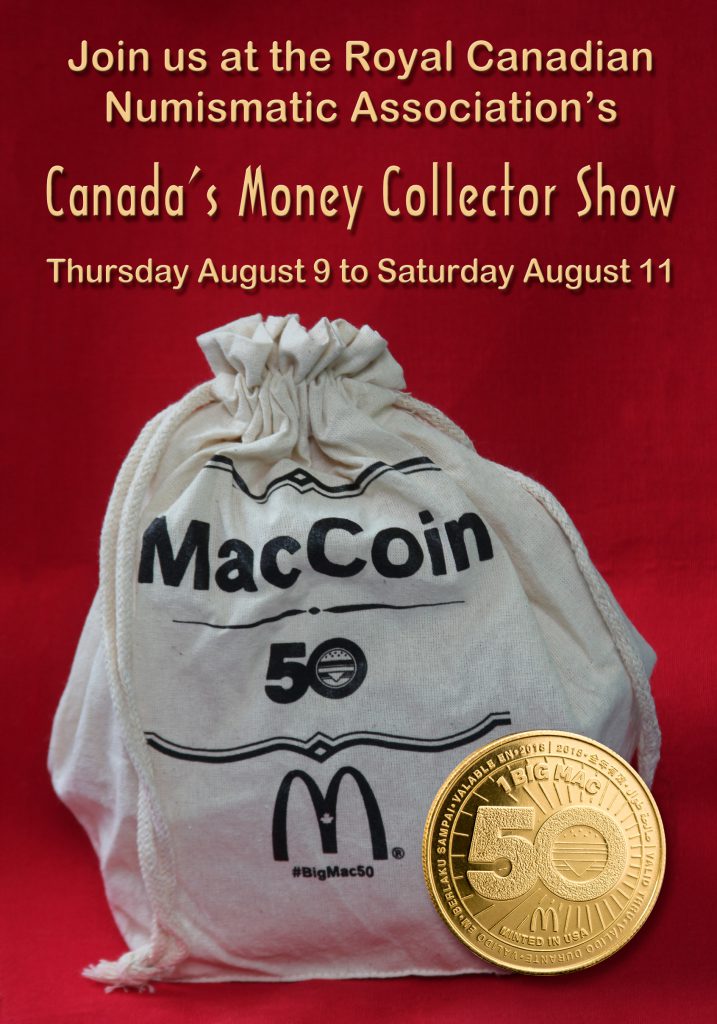By Henry Nienhuis
This August, McDonald’s launched a series of five commemorative tokens celebrating the 50th anniversary of the Big Mac.
There will be 50,000 coins issued in Canada and more than six million around the world, and they’re now redeemable for one free Big Mac at participating McDonald’s restaurants through 2018.
Dubbed the “MacCoin,” the new token – with five different designs – will be available to attendees of the Royal Canadian Numismatic Association (RCNA) Convention in Mississauga, Ont., on Aug. 7-11. All guests will be given a MacCoin for either their use or collection. In addition, attendees will have a chance to win a complete five-token set of MacCoins by entering a ballot in a free draw. Finally, for those who are unable to attend the convention, the RCNA’s Facebook page will also host a contest requiring participants to answer a coin-related question.
The Big Mac was invented in 1967 by Jim Delligatti in Uniontown, Pa., and was introduced to Canada the following year. Delligatti was one of the first franchisees of McDonald’s founder Ray Kroc. Initially sold for 45 cents, the Big Mac is now offered in McDonald’s restaurants in more than 100 countries around the world.
“When my great-grandfather Jim Delligatti invented the Big Mac at his grill in Uniontown, Pa., he just wanted to make his local customers happy,” said Delligatti’s great-grandson Nick, who’s also a fourth-generation McDonald’s owner-operator.

McDonalds CEO Steve Easterbrook celebrates the 50th anniversary of the Big Mac with the MacCoin and the family members of the late inventor, Jim Delligatti, on July 26 in Chicago.
ISSUED AUG. 2
The MacCoin, which was issued worldwide on Aug. 2, is advertised as the first fully food-backed currency: valued at “1 Big Mac” and redeemable for one of the two-patty, three-bun sandwiches at participating restaurants, it’s now accepted in more than 50 countries around the world.
“Aug. 2 would have been my great-grandfather’s 100th birthday, and I believe he would be very proud knowing his humble sandwich has made such a lasting impression that people all around the world can enjoy it wherever they find a McDonald’s,” added Nick Delligatti.
The MacCoin drew inspiration from the Big Mac Index, which was established by The Economist in 1986 as a measure of global purchasing power – an international “new gold standard” currency with its own exchange rate.
“It is based on the theory of purchasing-power parity (PPP), the notion that in the long run exchange rates should move towards the rate that would equalise the prices of an identical basket of goods and services (in this case, a burger) in any two countries,” reads a story published in the London, England-based magazine this July.
This theory about a currency’s PPP was first developed in the 1920s by the Swedish economist Gustav Kassel.
“As one of the most well-known and iconic McDonald’s menu items – and business driver – around the globe and in Canada, the Big Mac deserves the celebration that the coin evokes,” said Jeff McLean, chief financial officer of McDonald’s Canada. “The fact that in 50 years, the Big Mac has become so universally recognized it’s used to measure the purchasing power of international currencies is pretty remarkable.”
MACCOIN DESIGN
The MacCoin’s obverse design features a large “50” in the centre with “1 BIG MAC” at the top and the McDonald’s logo as well as “MINTED IN USA” at the bottom. The outer legend “VALID THRU 2018” is repeated in seven languages representing the many countries participating in the promotion. They include Arabic, English, Indonesian, Mandarin, Portuguese, French and Spanish.
There are five unique designs, each representing one decade of the Big Mac’s history. The coins feature elements from the various eras of the past half century, highlighting art, music and pop culture on the reverse while the common obverse celebrates the 50th anniversary of the Big Mac.
The coins highlight:
- the 1970s (1968-78), showcasing the decade’s flower power;
- the 1980s (1978-88), alluding to pop art;
- the 1990s (1988-98), defined with bold, abstract shapes;
- the early 2000s (1998-2008) specifically focusing on the technology that was at the forefront of the turn of the century; and
- the 2010s (2008-18), calling attention to the evolution of communication.
Each of the series’ five tokens measures 32 millimtres in diameter and 1.625 mm thick with a weight of 10.89 grams. Struck in brass, the tokens have a reeded edge and are struck with an upright alignment.
The total mintage for the five designs is about 6.2 million tokens.
The tokens were struck by Osborne Coinage Company, which is the oldest private mint in the U.S. according to the company’s website, osbornecoin.com. The company was originally founded in 1835 as Z. Bisbee Co., of Cincinnati, Ohio, and after a number of name changes settled on its current name in 1947.
The company is notable for minting the presidential campaign medals for Abraham Lincoln’s successful campaign (as well as for eight other presidential candidates).
In 2006, the company also produced the last series of bi-metallic tokens for the Toronto Transit Commission.


